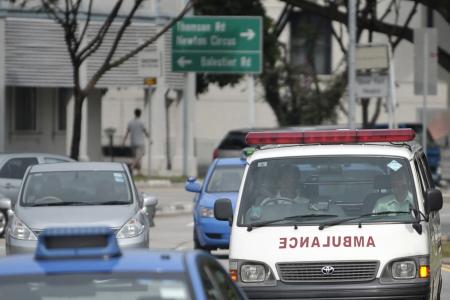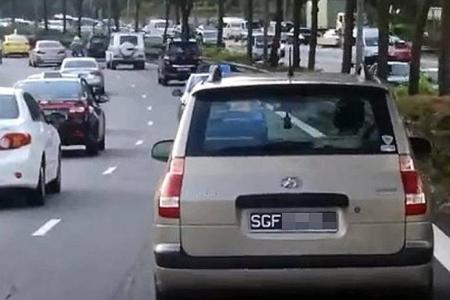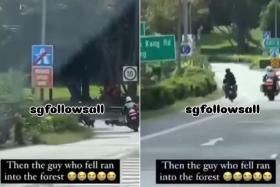Ambulance rushing woman to hospital blocked on PIE: Heartless road hog causes deadly delay
When inconsiderate drivers block the way of emergency vehicles, others have to pay, sometimes even with their lives.
One such driver is likely to have worsened an already critical situation by ignoring the sirens of an emergency ambulance that was rushing a 45-year-old woman to hospital.
The five-minute delay may have resulted in the woman having to be warded in the Intensive Care Unit (ICU).
The woman's son asked that details, such as his mother's full name and the Government Restructured Hospital where she was warded, be left out to avoid trouble with the motorist.
His mother, Madam Whey, had breathing difficulties at her Sims Drive home. So her sons called for an ambulance to take her to hospital.
Student Nicholas Whey, 21, said he had to get a private ambulance as the hospital which had all her records was not the nearest one to their home.
But as the ambulance made its way on the right lane of the Pan Island Expressway with sirens blaring, it was slowed down by the driver of a Hyundai Matrix.
For five minutes, the driver refused to give way, even as others in front of him filtered out of the fast lane.
At one point, the driver even braked for no reason, forcing the ambulance to do the same.
Said an upset Mr Whey: "My mother's oxygen level was already so low and she was drifting in and out of consciousness.
"This vehicle came in and just blocked the way, even jam-braking at times."
Angry, he took out his phone and recorded a 1½-minute video.
It showed the car braking, followed by a bang.
THROWN FORWARD
"That was the sound of the paramedics being thrown forward," he said, because the ambulance also had to react by breaking.
"At that time, they were administering fluids and attending to my mother."
On board the ambulance was the driver, two paramedics, Madam Whey, Mr Whey and his brother.
They were all flung forward when the ambulance was forced to brake.
Mr Whey said that when the ambulance tried to overtake the car, the driver sped up to prevent the ambulance from doing so.
He started recording only after noticing what the driver was doing and he had to stop filming because he did not want to distract the ambulance driver.
"After I stopped recording, it had already been about five minutes that this had been going on," he said.
"Finally, the ambulance driver had no choice but to pick up the loudhailer and read out the driver's licence plate to ask him to move."
It was only then that the driver of the Hyundai moved to the left and allowed the ambulance to pass.
By the time the ambulance reached the hospital, Madam Whey was semi-conscious and reacted only to pain.
She was warded in the ICU and diagnosed with chronic obstructive pulmonary disease as well as sepsis.
It is not known when she will be discharged.
"I'm just so angry," said Mr Whey.
"How can people do this? I really didn't expect that people would do something like this."
FILE REPORT
A spokesman for Singapore Emergency Ambulance Services (Seas), which provided the ambulance, said it will be filing a report with the Traffic Police.
The spokesman said that such incidents happen, but the ambulance drivers are advised not to use the loudhailer except in critical situations.
"We tell our drivers to try not to use the loudhailer, but in this case, it was required and our driver was in accordance with protocol.
"We file reports on a case-by-case basis, and in this case, it was an emergency.
"We will leave it in the hands of the Traffic Police to pursue the matter," said the spokesman.
Under the Civil Defence Act, it is an offence to obstruct a person carrying out or performing emergency duties. Offenders can be fined up to $5,000, jailed up to six months, or both.
Under the Road Traffic Act, obstruction of emergency vehicles responding to an emergency carries a fine of not more than $160 and four demerit points.
Offenders can be charged under both acts.
MP Seng Han Thong, who is the deputy chairman of the Government Parliamentary Committee for Transport, said that such cases are rare.
"Singaporeans generally give way, but one or two do not," he said.
"This type of incident happens very seldom and we need to work on, one, the congestion on the roads and, two, the mentality of drivers.
"If we all learn to give way, we can have better roads for all."
But private ambulance operators The New Paper spoke to said they do not usually report such incidents as it is too much of a hassle.
A Singapore Civil Defence Force spokesman told TNP earlier this year that only one ambulance obstruction case was reported to the Traffic Police last year, with three similar cases in 2012.
Finally, the ambulance driver had no choice but to pick up the loudhailer and read out the driver's licence plate to ask him to move.
- Mr Nicholas Whey, whose mother was being rushed to hospital
Some drivers ignorant, some just nasty
The director and owner of private emergency service, AME Ambulance Services Arthur Toh, prefers to "bite the bullet" instead of report obstructions.
"There is nothing much we can do, even if we lodge a report," Mr Toh, 59, said.
"Usually, I just bite the bullet and let it go."
Why do some people not give way?
It is mostly because of ignorance, he said.
"Most people don't give way because they don't know. But some of them are just nasty people."
It is also uncommon for an ambulance to use a loudhailer, even in critical situations.
"Every ambulance is equipped with a loudhailer," said Mr Toh.
"But in all my 10 years of driving an ambulance, I have never heard of anyone using it.
"For that driver to have used it, he must have been very frustrated."
Mr Toh said that he encounters inconsiderate drivers at most once or twice a month.
For Mr Sivachandran Murugasu, however, it is a common occurrence in his 11 years of driving an ambulance.
The founder of nursing company Abella Agency said: "It happens about three out of the five times I drive."
The 32-year-old recounted an incident last year when a taxi driver refused to give way despite the ambulance flashing beacon lights and blasting the sirens.
This happened along the Central Expressway towards Ang Mo Kio.
FLASHED FINGER
Mr Sivachandran said: "When our vehicles finally exited the tunnel, the taxi driver even flashed his middle finger at me."
He later lodged a complaint against him.
Mr Sivachandran uses beacon lights and sirens only during emergencies.
"These include situations when the patient has collapsed, has breathing difficulties or is bleeding profusely."
But he feels that vehicles should give way as long as the ambulance is driving in the first lane.
He said: "The main priority for us is to send patients to the hospital quickly to get assistance.
"For patients in critical condition, a slight delay can cost their lives."
WHAT IS COPD?
Chronic obstructive pulmonary disease (COPD) causes a loss of lung function, while sepsis is a potentially life-threatening inflammation from a severe infection.
According to the Chronic Obstructive Pulmonary Disease Association (Singapore) website, COPD consists of two chronic lung diseases: Emphysema and chronic bronchitis.
These diseases are characterised by obstruction to air flow in and out of the lungs.
COPD symptoms include chronic cough, phlegm and shortness of breath.
Acute infections or weather conditions may worsen the symptoms.
COPD is incurable, but treatment can help to ease the symptoms and slow the damage to one's lungs.
Types of treatment include using inhalers, vaccinations and undergoing oxygen therapy.
Get The New Paper on your phone with the free TNP app. Download from the Apple App Store or Google Play Store now



